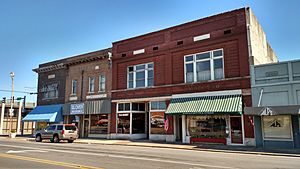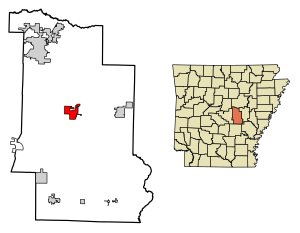Lonoke, Arkansas facts for kids
Quick facts for kids
Lonoke, Arkansas
|
|
|---|---|
| City of Lonoke | |

Downtown Lonoke
|
|

Location of Lonoke in Lonoke County, Arkansas.
|
|
| Country | |
| State | |
| County | Lonoke |
| Township | Lonoke |
| Incorporated | January 22, 1872 |
| Named for | "Lone Oak" |
| Government | |
| • Type | Mayor–Council |
| Area | |
| • City | 4.90 sq mi (12.70 km2) |
| • Land | 4.81 sq mi (12.45 km2) |
| • Water | 0.10 sq mi (0.25 km2) |
| Elevation | 233 ft (71 m) |
| Population
(2020)
|
|
| • City | 4,276 |
| • Density | 889.54/sq mi (343.45/km2) |
| • Metro | 610,518 (Little Rock/North Little Rock |
| Time zone | UTC-6 (CST) |
| • Summer (DST) | UTC-5 (CDT) |
| ZIP code |
72086
|
| Area code(s) | 501 |
| FIPS code | 05-41420 |
| GNIS feature ID | 2404954 |
| Major airport | LIT |
Lonoke is a city in Lonoke County, Arkansas, United States. It is the second largest city in the county and serves as its main government center. In 2020, about 4,276 people lived here. Lonoke is part of the larger Little Rock metropolitan area.
Contents
Discovering Lonoke's Past
Lonoke's story began during the American Civil War. Union soldiers moved through central Arkansas. The nearby town of Brownsville was burned down. This happened after Confederate soldiers moved west towards Little Rock. After the war, leaders from Brownsville decided to build a new town. They wanted it near the railroad so people could stay.
How Lonoke Got Its Name
Local stories say the town was named after a big red oak tree. This tree was found when people were clearing land for houses. The town's first official name was "Lone Oak." But a newspaper, the Lonoke Democrat, made a mistake. They printed the name as "Lonoak." Over time, this misspelling changed again to "Lonoke."
Growing Through the Years
Lonoke grew slowly at first. Its economy relied on farming. This helped the town keep a steady number of people until World War II. After the war, many babies were born, leading to a "baby boom." This caused Lonoke's population to grow. Also, the building of Interstate 40 made Lonoke a suburban area near Little Rock.
Today, Lonoke's population stays around 4,000 people. As the Little Rock metropolitan area gets bigger, Lonoke is expected to grow too. It is becoming a more popular place for people to live outside the main city.
Eberts Field: A Local Airfield
Eberts Field was an important airfield near Lonoke. The United States Army used it to train pilots. This training happened during both World War I and World War II.
Lonoke's Location and Land
Lonoke is located in the central part of Lonoke County. The United States Census Bureau says the city covers about 4.90 square miles (12.70 km2). Most of this area, about 4.81 square miles (12.45 km2), is land. The rest, about 0.10 square miles (0.25 km2), is water.
Learning in Lonoke
By 1879, Lonoke had enough people to need free public schools. The state gave some money, but citizens raised an extra $10,000. This money helped start a free public school. It offered classes for ten months each year.
Public Schools in Lonoke
Lonoke does not have colleges because it is a smaller, rural town. However, it has a public school system. This system includes a primary school, an elementary school, a middle school, and a high school. Lonoke High School students have good test scores. Many graduates go on to higher education. About 45% of them attend Arkansas State University Beebe.
Special Education Opportunities
Lonoke is also home to the main campus of the Lonoke Exceptional School. This school helps children and adults with different developmental disabilities. It has served Lonoke and nearby areas since 1972. The main campus in downtown Lonoke was built in 1991.
Lonoke's Population Over Time
| Historical population | |||
|---|---|---|---|
| Census | Pop. | %± | |
| 1880 | 659 | — | |
| 1890 | 858 | 30.2% | |
| 1900 | 951 | 10.8% | |
| 1910 | 1,547 | 62.7% | |
| 1920 | 1,711 | 10.6% | |
| 1930 | 1,674 | −2.2% | |
| 1940 | 1,715 | 2.4% | |
| 1950 | 1,556 | −9.3% | |
| 1960 | 2,359 | 51.6% | |
| 1970 | 3,140 | 33.1% | |
| 1980 | 4,128 | 31.5% | |
| 1990 | 4,022 | −2.6% | |
| 2000 | 4,287 | 6.6% | |
| 2010 | 4,245 | −1.0% | |
| 2020 | 4,276 | 0.7% | |
| U.S. Decennial Census | |||
People in Lonoke: 2020 Census
The 2020 United States census counted 4,276 people living in Lonoke. There were 1,676 households and 1,075 families.
| Race | Number | Percentage |
|---|---|---|
| White (non-Hispanic) | 2,664 | 62.3% |
| Black or African American (non-Hispanic) | 1,152 | 26.94% |
| Native American | 8 | 0.19% |
| Asian | 31 | 0.72% |
| Pacific Islander | 1 | 0.02% |
| Other/Mixed | 169 | 3.95% |
| Hispanic or Latino | 251 | 5.87% |
Famous People From Lonoke
Many notable people have connections to Lonoke:
- Maurice Britt (1919–1995): A football player, businessman, and a highly decorated soldier. He grew up in Lonoke.
- Ed Hamm (1906–1982): A track and field athlete who won a gold medal at the 1928 Summer Olympics.
- Jim Lee Howell (1914–1995): A football player for the NY Giants and later a coach.
- James B. Reed (1881–1935): Served as a U.S. representative from 1923 to 1929.
- Joseph Taylor Robinson (1872–1937): A U.S. Senate Majority leader and Al Smith's running mate for Vice President.
- Thomas Clark Trimble III (1878–1965): A former federal judge.
- Will Walls (1912–1993): An American football player.
See also
 In Spanish: Lonoke para niños
In Spanish: Lonoke para niños


